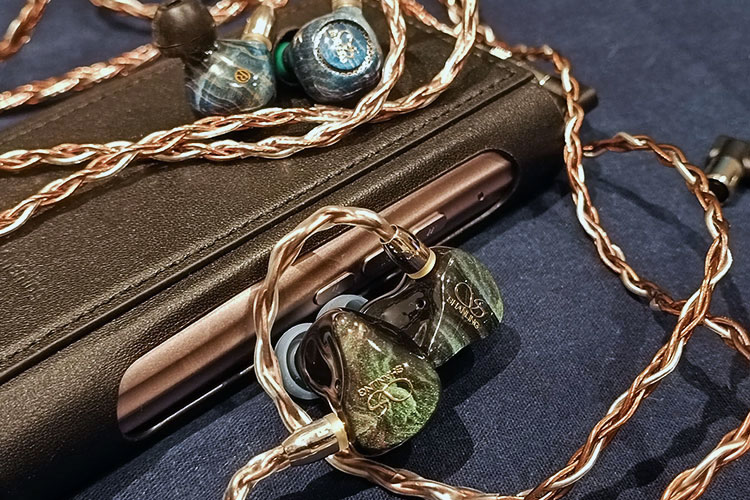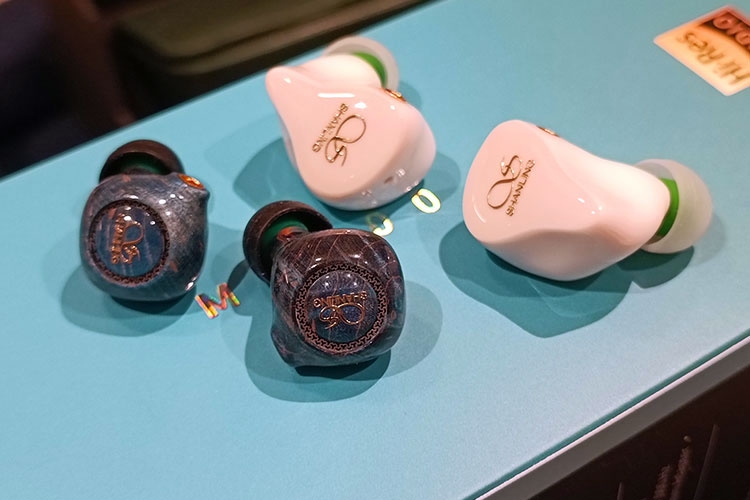Synergy
Efficiency
The MG600 is rated at 22Ω, 105dB which is moderately sensitive. While dongles can drive it quite loud and dynamic, when putting it on a powerful DAP you can feel the tonal balance and bass quality, also the treble control is superior. The texture in the mid-lows, also layering is also much stronger when sufficiently powered.
Being quite sensitive and without much dampening in the filter design, I find the MG600 quite responsive to the decoding quality from high-end gear such as the Chord Electronics Hugo 2.
The tuning that stresses the two ends allows the MG600 to sound defined and dynamic on smaller outputs such as the Cayin RU6. When feeding it more raw power or current, the mid-range will sound livelier with the midrange being more textured or when slightly thickened.
Pairings
Using the Shanling M7 to test, the output is expansive and textured. There is enough speed and transparency to not color the vocal warm with the vocal body on the moderately light side.
The vocal on this pairing sounds authentic and smooth, with the harmonic tones elevated that intensify lighter voices and help define instruments better. Male vocalists sound smooth and more laid back and lighter female vocals are swiftly presented with good sweetness from the delicate roll-off.
The treble has nicely preserved the brilliance in the music as well as air and openness, and the light tuning is great for electronic music, game music, and pop. There is good synergy with music that has strong sound effects applied on the overtones and is able to define clean voices effortlessly and relaxingly.
On balanced output the MG600 sounds wider, stretching the vocal image broader and less analytical. When switching to 3.5mm output the MG600 sounds more cohesive and denser in the mids.
Putting the MG600 on the Soncoz SGA1 desktop amplifier that is able to deliver stronger swings, the mid-bass is immediately strengthened in resolution and body. The vocal is pushed more forwarded and cuts through the mix clearer.
The MG600 gulfs up the amplification power well to sound fuller in body and more euphonic, while the rounded treble allows more room for the MG600 to sound controlled under higher gain and power that pushes the vocal more forwarded.
Select Comparisons
Shanling ME800
$779
Technical
The ME800 is the current flagship under Shanling’s IEM lineup and comes with a dual dynamic driver plus quad BA driver configuration. The MG600 on the other hand has only 1 single DD and is significantly different in design featuring a resin-infused wood housing and a vented acoustic system.
Design
The ME800 is one of the most recent items from Shanling and is housed in a resin enclosure, in the form of a universal CIEM with swirl patterns on top that is unique to each build. The MG600 is more unusual in design compared to most IEMs in the market and also differentiated from Shanling’s other IEMs that use metal and resin as housing.
It would require more design effort as we can see the filtering system and internal parts are quite uncommon. I am quite surprised by the positioning of the MG600 as a design from the ground up would be more costly.
One similarity is that the cables of the ME800 and MG600 are identical. While the ME800 features tuning switches, the MG600 has a more unique and original design that makes both IEMs social in their own ways.
Performance
The MG600 feels less sensitive and requires more current to drive, though its performance is more apparently scaling with different sources.
When sufficiently powered, the bass on the ME800 kicks deeper and has more presence. The MG600’s mid-range is smoother and more relaxed for casual listening, though not as eminent in micro-details retrieval compared to the BA-based ME800.
The character of the two IEMs is diverse, where the ME800 focuses on transients and details on both ends and MG600 renders smooth, natural mid-range without compromising openness.
When listening outdoors you can pick on the details easier on the ME800 which positions instruments clearer, but the MG600 will sound more relaxing and less distracting. The less confined image rendered on the MG600 put together a more soothing headroom, that works well for solos and sweetens up vocal works.
The treble seems more pronounced on the MG600 yet it is smoothened and rounded off sharper such that it is not spikey and able to cope with voices that are very energetic. Both MG600 and ME800 pair well with high outputs though the ME600 can handle sharpness better.
In general, the MG600 sounds truer to live music and has an advantage in being airier and more open, while some technicalities are sacrificed it is free from being artificial sounding with the articulation being smoother.
You would not feel the difference in speed between drivers like on hybrid designs, especially when powered by outputs that are less strong in power.
Shanling ME700 Lite
$499
Technical
The ME700 is a 5-driver hybrid that houses 1DD and 4BA, measuring 16ohm and 109dB in sensitivity which is quite easy to drive. The dynamic driver inside has a rigid titanium-based membrane, which boosts speed and dynamics while being very sensitive.
Design
With a glossy white housing, the ME700 Lite targets younger listeners and the design aligns well with its light-hearted tuning.
The cable on the ME700 Lite is also different from the darker ones we normally see from Shanling, using a dual-toned gold and silver theme embedding SPC and gold-plated copper cores.
The MG600 looks comparatively more appealing and premium in this case with its stabilized wood housing and proprietary design. On the other hand, the cable gauge is thicker on the MG600 and feels more premium, also coming with a swappable system that is more convenient.
Performance
The ME700 Lite is more sensitive than the MG600 and could sound really loud and clear on a phone or an iPad. That gives it some edges if you are pairing both IEMs with a low-power device or on dongles.
When powered by a more powerful DAP the MG600 has more potential to scale and does sound fuller in the mid-range, also boosting the clarity and openness in the upper register.
With synthesized instruments, the ME700 Lite sounds more vibrant, and it also works well with ACG and game music genres to sound energetic and pronounced in vocals.
The MG600 is more loyal to the recording and rounded even when powered by a stronger source, you could feel the staging being more complete with the fuller bass energy, while the tonality makes it a better match with acoustic instruments and vocal recordings.
On the ME700 Lite, the focus will be on cymbals, and percussion instruments with the mids more pressed down. The MG600 has more body in the mid-lows and it does not emphasize the higher frequencies as sharply as the ME700 Lite.
The MG600 clearly has more potential to scale. With a higher gain, the ME700 Lite is not as controlled in the treble as the MG600, but on phones and dongles, the ME700 Lite could well compensate for the lack of clarity or an early roll-off.
Dethonray Tender 1
$639
Technical
The Dethonray Tender 1 is a rather insensitive planar dynamic IEM in a metallic housing made from CMF-processed, aviation-grade aluminum.
The 10mm planar magnetic, fully-closed design measures 28ohm and 98dB in sensitivity and would require more power than the MG600 to drive it to full potential.
Design
The two in-ear designs with 1 driver are significantly different from each other as the Tender 1 is closed and uses a metallic chamber as a tuning measure for better tonal accuracy.
The MG600 uses wood filters and a wood-resin hybrid housing that matches the characteristics of the dynamic driver. We can see how manufacturers achieve a favorable tuning using the housing as a part of the acoustic design.
When it comes to the cable, the Tender 1 uses silver cores but does not feature the interchangeable system as on the MG600. Interestingly, swapping the cables of the two IEMs yields favorable results too.
Performance
The Tender 1’s planar driver has distinct characteristics like its speedy response and transients in the treble, together with a full and meaty bass tuning. This gives it a bolder image than on the MG600 which is less meaty in the mid-lows and is more naturally extended in the higher vocal range.
While the impact is faster on Tender 1, it is colored with an expressive decay in the mid-bass region, which sounds very dense and full when sufficiently powered. The coloring is quite a bit stronger than on the cleanly toned MG600 which has the mid-bass more pressed down for smoothness.
The Tender 1 will require a lot more power and gain to sound as clean and balanced as the MG600 on a mid-end DAP. It will require a powerful and cleanly toned DAP while the MG600 sounds better with DAPs that render the lows stronger and fuller to compensate for its less-strong coloration.
In short, the Tender 1 is more leaned to the bass and is more power demanding, while its mid-bass is more elaborated, dense, and textured. The MG600 is more forgiving on power requirements and can sound punchy and responsive in the mid-lows without being boomy.
With an opened design it surpasses the Tender 1 in separation and renders more space between instruments as well as a more open stage.
Our Verdict
The Shanling MG600 has demonstrated the company’s design expertise and is a very unique IEM internally and externally.
The tuning is expansive and immersive with plenty of detail and a bass impact that is quite powerful. The tips tuning package is a factor in the final output and you can clearly hear some differences when rolling tips.
It would be even nicer if the MG600 is slightly more sensitive, or stronger in passive noise isolation, but that is too much to ask for looking at the unique design and the price.
Some manufacturers are attempting to build semi-opened earphones but the MG600 is comprehensively the most appealing version to date with a stunning design, suitable for those who prefer openness and low coloration in sound.
Shanling MG600 Technical Specifications
- Cable length 1.3m
- Driver: 10mm Dynamic Driver
- Impedance: 22ohm
- Frequency response: 20 – 40kHz
- Sensitivity: 105 +-3dB
- Weight: 3.3g per earphone
- Connectors: 2.5/3.5/4.4 mm









